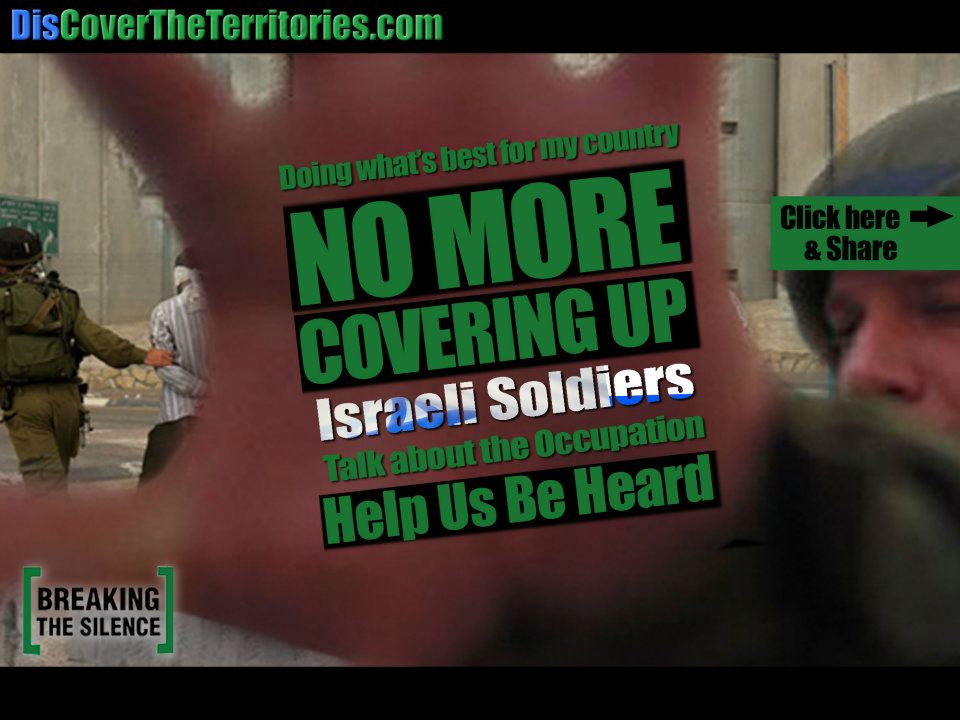In summer 2010, after much hesitation, I went with Breaking the Silence to Hebron.
In retrospect, that trip was the final chapter in my personal process of transformation from a “liberal” to a “leftist” when it came to Israel and the Occupation (a process that began with “Operation Cast Lead” in the winter of 2009). Of course these terms are arbitrary, “liberal” and “leftist,” and everyone will use each of them in different ways. For me, though, the distinction comes largely in the level of intensity and absoluteness with which I opposed the Occupation and its tributaries of physical and systematic violence against the entire Palestinian population. Watching the War on Gaza from my computer screen manifested in my gut -unable, despite my desperate desire, to see the war as justified, and to avoid the conclusion that Israel’s leaders and military were enacting a sort of collective punishment on an entire population- as a shrieking, clawing, death-heavy feeling of the Occupation. My first trip to Hebron pushed a weight into my chest in a quieter, more delicately nauseating way.
It was quiet, when we went there, to Hebron. We did not witness any active violence, or see any Palestinians being hurt. Actually: we barely saw any Palestinians. Shuhada street, once a central area of Palestinian Hebron and basically off limits to Palestinians since Baruch Goldstein slaughtered 29 Muslim worshipers in 1994, was empty. The doors were barred shut, decorated with graffiti of Jewish Stars and nauseating slogans including “Arabs to the Gas Chambers.” Above the doors were cages, Palestinian balconies were caged off. “Some of them have to climb over roofs to get in and out of their houses,” our guide told us. And this wasn’t an “accident:” this was policy. I wanted to disbelieve what I was seeing, to disregard what I was hearing: but I couldn’t. Like many American Jews, I’d been able to “sift out” what I heard then as “radical pro-Palestinian rhetoric,” to not fully hear it, to tell myself, “no, I’m sure it’s more complicated then that.” But our guide was not your typical radical pro-Palestinian: he was a former IDF soldier. And so I heard, from him, what others had been trying to tell me. This is a complicated and uncomfortable thing to think back on, the fact that I had to hear it from a former Israeli soldier to believe it- but that is how it was. And suddenly, in one afternoon, the term “apartheid,” scrawled on a handwritten sign on one of the Shuhada street porch-cages, didn’t seem like such an outrageous description of the situation in the West Bank.
“Segregation” simply seemed like a statement of fact.
I could go on and on about what I learned, how I changed, what broke inside of me during that afternoon in Hebron, (and have gone on about in other venues, from my days organizing a protest against the “Hebron Fund” through J Street U, to the project I helped spearhead through Project Hayei Sarah, collecting pieces of video Torah on the situation in Hebron, to [an attempt at] selling Matzah Covers from a Palestinian Women’s Collective in Hebron on Ben Yehuda Street in Jerusalem) but I want to instead direct readers directly to Breaking the Silence, the group that had such a huge impact on me and many others, and their latest campaign which is launching today. The campaign is called “Dis-Cover the Territories,” and it is directed explicitly towards Americans and American Jews. While I cannot stress enough how important it is to go to Hebron in person, with Breaking the Silence, or Project Hayei Sarah, or on another tour, I also realize that not everyone is able or willing to make the journey into the absurd-reality of H2/Hebron.
Therefore, I’ll just ask this: take sixteen point eight two minutes, click the link below, browse through a few of these testimonies, and if you find something that you don’t like, don’t agree with, don’t believe, don’t turn it off. Please keep watching.
Dis-Cover the Territories.
Israeli soldiers talk about Occupation.


